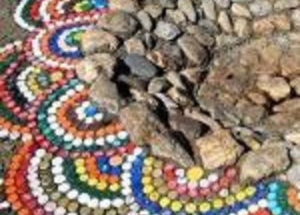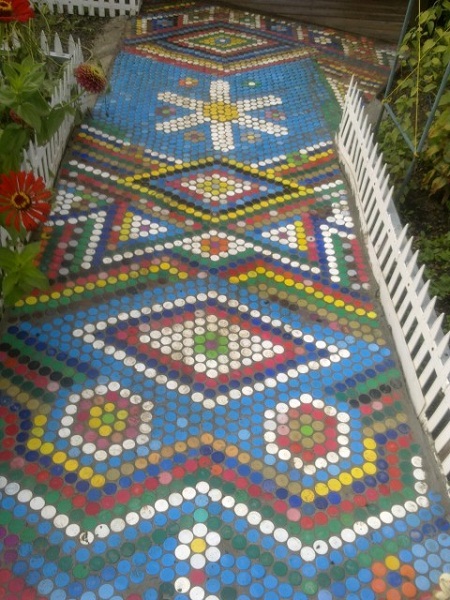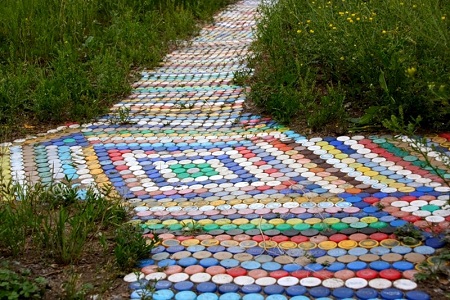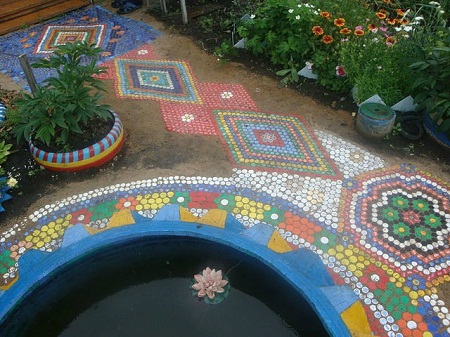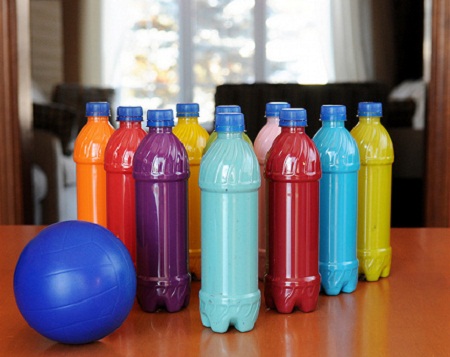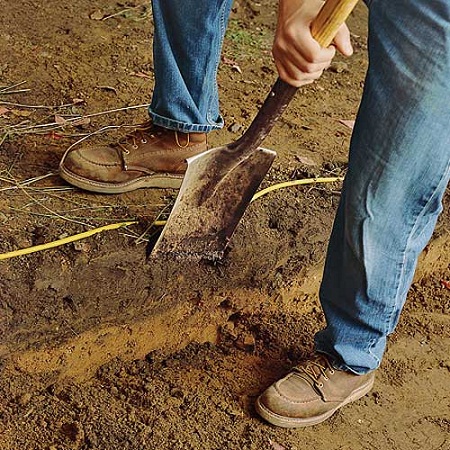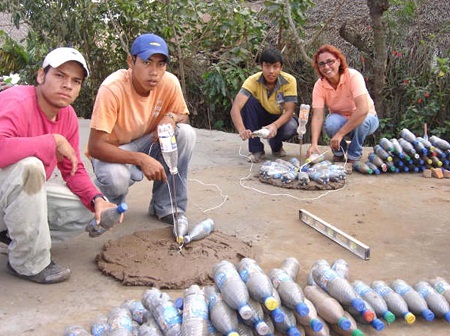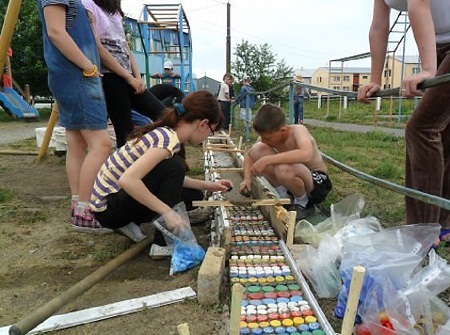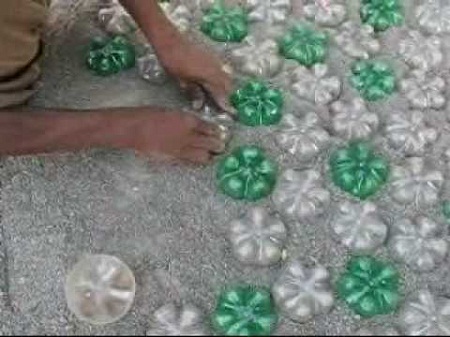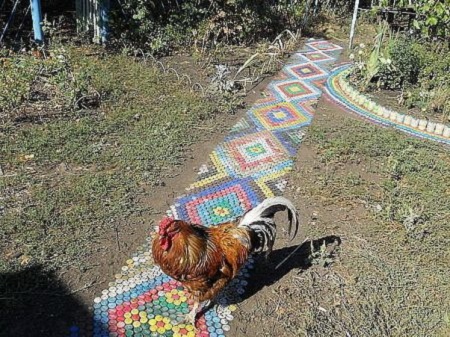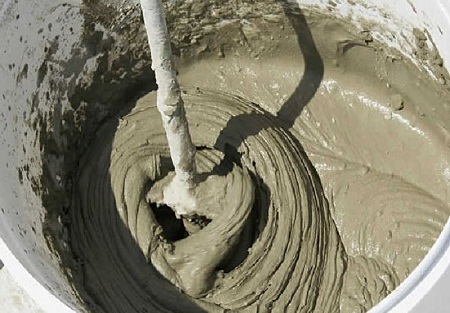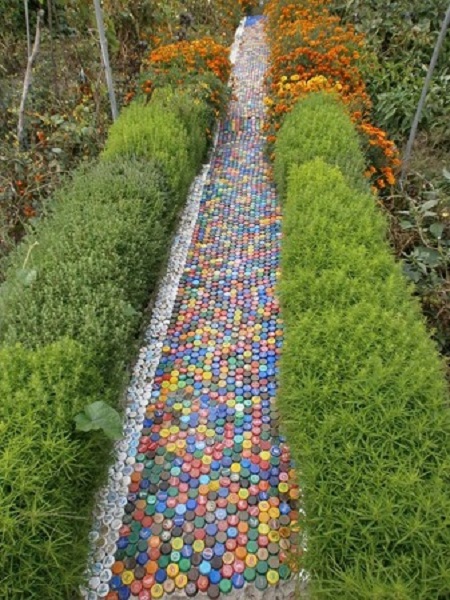Quite often, with the advent of summer warm days, forays out of town to the country, away from the hustle and bustle. After a few get-togethers with friends, a decent amount of garbage is collected. Most of it is made up of plastic bottles from a variety of drinks. This garbage can be disposed of to a landfill or burned. But we must remember that burning plastic causes irreparable damage to health and the environment. Since the plastic from which the bottles are made is strong and fairly easy to process, it is often used as a free material for all kinds of crafts. They very successfully decorate the fences, flowerbeds and gazebos.
Content
Paths from plastic bottles
There is one more, more practical way of using plastic containers - decorating the tracks on the site. Multicolored plastic will add a patch of brightness, originality and color. Friends and neighbors will admire and admire the innovation. Among other things, such paths will minimize the growth and spread of weed species of grass along the site.
Plastic material for manufacturing can be obtained without financial investments:
- it is possible, having set a goal, to collect independently;
- you can ask neighbors to give, not to throw out and so on.
Directly in the very process of work, one can involve the child, giving the will to the embodiment of his fantasies. Preparation for work will also be of interest to the child, because he will be entrusted with the material and task, and most importantly - the opportunity to show their creative abilities.
In order to start the construction of a path on the plot of land from plastic bottles you will need the following:
- to collect sufficient amount of plastic material, suitable in size and shade,
- determine the type of the desired track
- organize a place to work (dig a trench a little more than a bayonet spade into the depth and the required length)
- to make a reserve of sand
- mount a formwork box
- prepare working tools - a pair of boards equal to the width of the track, scoops and buckets, watering can.
Garden paths made of plastic bottles
The volume of bottles must be filled with earth or sand. This stage of work is better to offer to the child, as he will do it much more scrupulously and more responsible than the adult. The kid will turn this process into a game. From time to time, packagings with loose filling must be rammed, in other words, shaken, tapping the bottom against something solid and firm. Depending on the age of the child and the volume of the bottles filled, it may be necessary to shake the adult. In this case, do not forget that the baby should be periodically encouraged and praised.
Paths made from bottles in which there was yogurt, will definitely be picturesque and elegant. But for want of such, the usual transparent or translucent color ones are quite suitable. They can also be decorated. For this purpose, multi-colored magazine covers or colorful, bright packages are suitable. Of these, you need to cut rectangles that coincide in height and width with the size of the bottle. Then roll them with a tube and insert into the bottle. A rectangle hitting inside will unfold, and the ground or sand that gets inside fix its position. It will be interesting to look like a bottle filled with sand, which is pre-mixed with finely chopped foil, wrappers or simply with the addition of a dye, the color of which can be chosen based on your own preferences.
Filled bottles should be placed in a dug trench in a horizontal position, on a pre-decorated sand cushion. Before designing a sand pillow, a broken brick, various construction debris and a layer of earth are laid in the trench. To ensure that the bottles are at the same level, boards are placed on top of them and the cargo is placed or, using the weight of small assistants, evenly tamped, suggesting that they trample on the boards.
Formed gaps between the bottles filled with sand mixed with cement, and then also with the help of a board, rammed and leveled. Excess sand with cement is cleaned with a broom. After that, the path must be poured with water from the watering can. After a certain time, when the cement hardens, remove the formwork. The edges of the path, on which the necks of plastic containers are visible, are masked with stones, making original slopes.
Path from bottoms of plastic bottles
This variant of registration of tracks on a private plot is rightfully considered to be the most interesting and the most secure. Separate the bottom of the bottle will help the most ordinary scissors. By laying the bottoms on the path, you can attract children, because they like to add puzzles and mosaics, because they love to play in the sandbox. In this version, all the same preparations will be needed as in the previous one - mounting the formwork, tamping the land, decorating the sand interlayer, leveling and watering. As long as the sand is damp, you need to press the bottoms into it.
Of these, you can lay out, for example, a flower clearing and in addition to make color additions from the lids of all the same plastic bottles. If there is time, desire and a sufficient number of covers of the right colors, you can create whole pictures with their help, taking as a basis the scheme for embroidering with a cross.
Tracks from corks of plastic bottles
We have already mentioned that it is possible to use plastic bottles differently, in addition to the variants discussed above, one can still create a path of plugs. Of course, the matter is more troublesome, and it will not be easy to collect enough material. From the caps, you can create different types of coatings:
Even if the corks are laid upwards,
Ribbed, resembling a massage mat, when laying bottles down by bottoms.
The placement of such small fragments of the track will require the use of special technologies. For example, you can build a path, combined with ceramic tiles and plugs. To begin with, it is necessary to dig a trench, drive in supports and build a timbering formwork by installing spacers along its edges for strength. Further the trench is covered with rubble, we ram it. The collected corks are sorted by size and colors. Laying of finishing materials should be carried out on a solution made of sand, cement and glue for ceramic tiles in a proportion of 3: 1: 1, when preparing the mixture, water is better added gradually, do not make the solution liquid.
First, in staggered order lay the tiles, in the remaining free rectangles we lay the prepared glutinous mixture, level and gently press the caps into it. The work will need to be done quickly until the mixture grinds.
If the lids will not be laid on the solution but simply on moistened sand, then the strength of the track will be low. The use of such a small material as a lid from bottles will allow to lay out the surface of the path with beautiful patterns, but if desired, the lid can be placed in any order.
In any case, the time and effort spent on decorating the garden paths on the site in such an original way, will bring a visual delight to all family members and guests.


